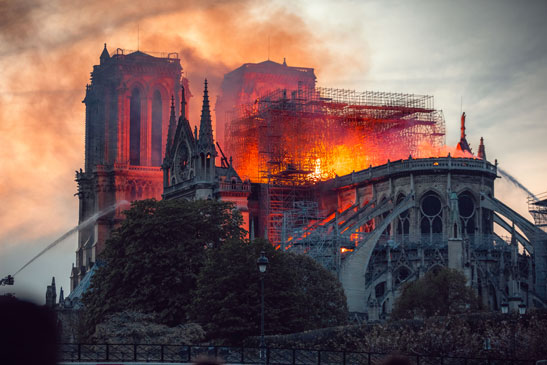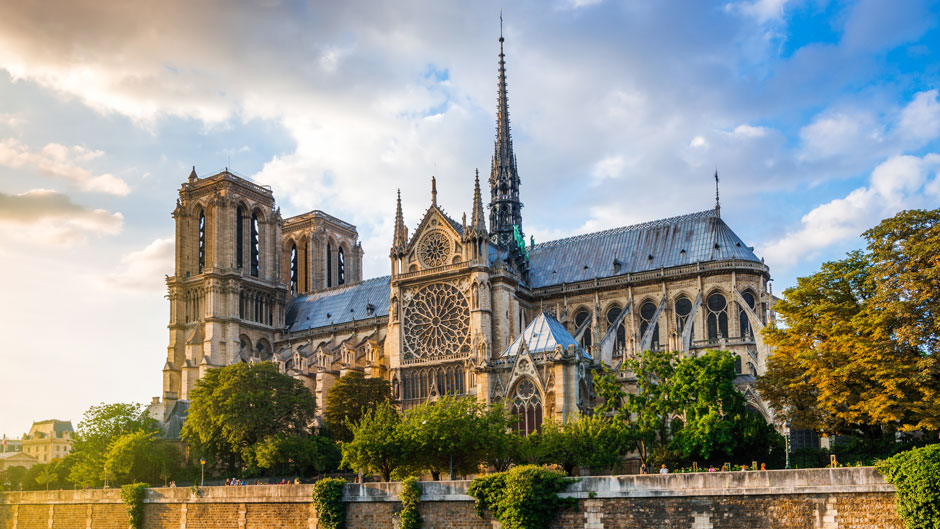In the first photos broadcast by news outlets and circulated widely on social media of the historic fire that consumed Notre Dame Cathedral’s roof and spire, the main sanctuary of Paris’ famed cathedral still stood. The gold cross at the altar glowed in the evening light. It was a symbol that many commentators across media platforms considered a Holy Week miracle.
Logan Connors, associate professor and director of undergraduate studies in French and faculty director of the University of Miami’s UParis program, said the blaze that ravaged Notre Dame was “a lesson in fragility—the fragility of France’s historic patrimony and of the seemingly timeless cultural markers that we sometimes take for granted.”
 The devastating fire broke out at about 6:50 p.m. local time Monday, spreading quickly along the roof of the cathedral, which was undergoing renovation work. Notre Dame – which translates to “Our Lady” in English – is a UNESCO World Heritage Site and is considered a marvel in Gothic architecture. The first cornerstone of Notre Dame was laid in 1163, in the presence of Pope Alexander III. The flying buttresses were installed in the late 13th and early 14th centuries, and construction of the cathedral was completed in 1345.
The devastating fire broke out at about 6:50 p.m. local time Monday, spreading quickly along the roof of the cathedral, which was undergoing renovation work. Notre Dame – which translates to “Our Lady” in English – is a UNESCO World Heritage Site and is considered a marvel in Gothic architecture. The first cornerstone of Notre Dame was laid in 1163, in the presence of Pope Alexander III. The flying buttresses were installed in the late 13th and early 14th centuries, and construction of the cathedral was completed in 1345.
The fire also revealed the cathedral’s role as a global site of emotion and connectivity, Connors said.
“I was surprised to see just how many people among my family members, friends, and colleagues—many who are in no real way Francophiles—were moved by the events. It seemed that everyone had a ‘Notre Dame story’ to tell and a ‘Notre Dame photo’ to post on social media.”
Notre Dame de Paris’ religious history is just part of its story. The cathedral has been woven into the social and political fabric of France since it was completed in the 14th century. With more than 12 million visitors every year, the cathedral is the most visited tourist site in all of Europe—a place of both religious and secular pilgrimage for people from around the world, said Connors.
The blaze ignited on the second day of Holy Week, the week before Easter as observed in Christianity. Holy Week masses would normally be taking place within the sanctuary of Notre Dame. Easter Sunday masses have been moved to the Church of Saint Eustache.
Historic artifacts and works of art, including the crown of thorns and other religious relics, were pulled from the burning building by first responders, while others had already been moved during the renovation process. Many pieces have been transferred to the Louvre Museum for safekeeping. The 18th century pipe organ – considered one of the cathedral’s many masterpieces – is also reported to be intact following the blaze. And while the main sanctuary and the historic bell towers appear to be saved, the Paris Fire Brigade warned it will take time before a full risk assessment of the cathedral’s structural integrity is completed.
“The age, the size, the stunning beauty, and the centrality of this cathedral conveys not only its religious significance for the devout but, as is often the case with other iconic religious structures, identifies the enduring values of a culture and a nation,” said David W. Kling, professor and chair of the Department of Religious Studies.
During a news conference from the Île de la Cité, French President Emmanuel Macron vowed to rebuild affected parts of the 850-year-old cathedral, and announced that donations have been pouring in from all over the world. France’s Fondation du patrimoine, a private organization dedicated to protecting French cultural and natural heritage, has created a donation fund to rebuild the cathedral.
“This lesson in fragility, however, will remain, and what is certain is that one of humankind’s most magnificent architectural achievements has been forced to turn a new page,” said Connors. “But as Victor Hugo said in his magisterial novel, ‘Notre-Dame de Paris,’‘Les grands édifices, comme les grandes montagnes, sont l’ouvrage des siècles(Great buildings, like great mountains, are the work of centuries).’”

